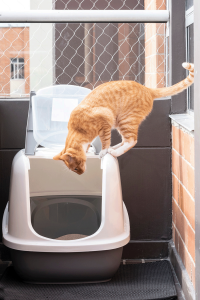The act of elimination (urination and defecation) is something veterinarians have to discuss with each client during every appointment. Understanding a patient’s bowel movements, water intake, urinary habits, and eating behaviors help to assess general health as well as pinpoint particular medical issues. Sometimes, for owners, discussing their pets’ “potty habits” can be a little awkward. You might think, “I’m not a dog, or cat, how am I supposed to know about animals pooping?” You may even wonder if your animal’s behaviors when eliminating are normal (just do a quick online search and look at all the questions about dog poop!).
Many factors shape where and how a dog, cat, or other animal chooses to poop or pee. Understanding animal behavior can help eliminate the mystery of elimination (pun intended!). As in most cases regarding medicine, one must first learn “normal” before understanding what is “abnormal.”
Elimination behavior begins at birth. For the first few weeks of life, puppies and kittens are dependent on their mothers. Mom will gently lick and clean the urogenital region of their babies to promote defecation and urination. This act also assists to maintain clean hygiene and keep the den space clean to reduce parasite load, ammonia buildup and potential attraction of other animals. Around 3 to 4 weeks of age, puppies and kittens become more mobile and can ambulate around the den. At this time, they will be able to eliminate on their own, and start choosing locations based on innate preferences.
Dogs and cats have a preference to eliminate 1) on porous surfaces (i.e., grass, carpet, dirt), 2) in a place where elimination has occurred previously, and 3) away from their sleeping and eating locations. Young animals will need to eliminate more frequently—puppies can hold their urine approximately 1 hour for each month of age (so a 4-week-old puppy will pee once an hour, on average). Other factors that will affect where our fur kids choose to eliminate include environmental noises, temperatures, smells, animals, etc. For example, many dogs will be less willing to defecate when it is raining outside. And a loud noise—perhaps the laundry machine starting up—can startle a cat right out of the litter box.
When a dog does decide to eliminate, there are common behavioral patterns to expect. They will show more interest in sniffing and smelling, circling behaviors, and interest in a particular location. Some may lift their leg or squat to urinate. Often, a squatting posture is used with tail lifted for defecation, although there can be some variation. Some dogs may scratch afterward to partially cover their excrement. There can be other ritual aspects to a dog’s elimination pattern that are individualized from dog to dog.
Cats are generally litter box trained if they’re indoor cats, and they’ll often scratch around first in the substrate/litter material provided prior to eliminating. Urination and defecation are generally done while squatting. Intact males may also mark, which is a separate behavior from elimination but can be misinterpreted by owners. This behavior usually includes a pattern of backing up to a vertical surface with tail up to spray the wall, furniture, tree, etc. Cats generally engage in more digging afterward to cover their excrement. If the litter box isn’t cleaned frequently, the ammonia from the urine can build up and irritate their respiratory passages, leading to litter box aversion. Other medical issues, such as lower urinary tract disease, arthritis, and hormonal diseases may also lead cats to urinate elsewhere (often on soft substrates, such as towels, bedding or clothing).
I believe the most important symptom owners can look for is a change in a pet’s elimination pattern. That should be a signal to owners that it’s time to ask your veterinarian to rule out a medical issue, through diagnostics that may include bloodwork, urinalysis, X-rays, and other tests.



